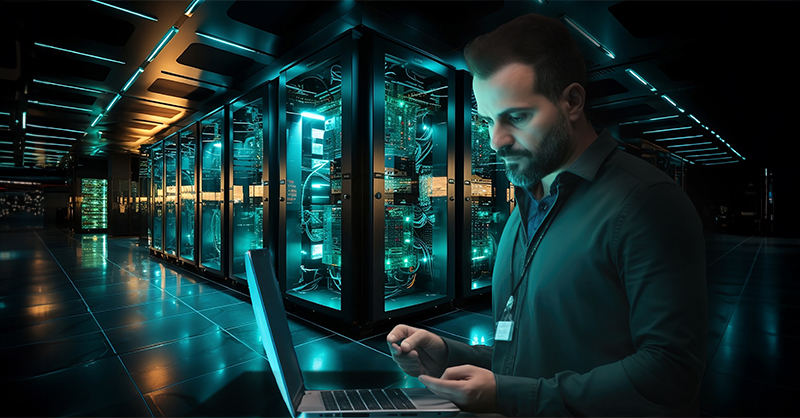
There is a common belief that utilizing mainframes is like living in the past, while many others wonder who uses them anymore. However, the answer is surprising: just about everyone. If you have used an Automated Teller Machine (ATM) to interact with your bank account, you have just used a mainframe.
Mainframes continue to play a pivotal role as the backbone of the daily operations of major enterprises, spanning sectors such as banking, airlines, and telecommunications, by hosting mission-critical applications and data. Undeniably, all of these organizations also pursue digital transformation initiatives and eagerly aim to harness the advantages of cloud computing, seeking to boost business agility, foster innovation, and elevate customer experiences and employee productivity.
This is where Mainframe Modernization comes to the rescue, with a significant goal of efficient cost management and extracting maximum value from IT investments. In this blog, we shall explore the security challenges of modernizing mainframes, emphasizing the importance of mainframe security and addressing evolving needs during modernization. You will also find insights and practical tips for mitigating risks, particularly in a hybrid cloud approach.
What is Mainframe Modernization?
.jpg?width=800&height=418&name=3%20(1).jpg)
Imagine inheriting an architecturally splendid mansion from your forefathers with massive walls ensuring tight security and comforting past generations. When handed down to you, while still admiring its grandeur, security, and charm, you aspire to customize it to align with contemporary trends. You envision seamlessly blending its classic charm with cutting-edge technology, incorporating smart home features.
This process is similar to preserving the timeless architecture - the mansion (legacy mainframe) while updating the interior, wiring, and amenities (hardware, software, and applications) to align with modern living standards.
Mainframe modernization embodies this concept precisely by harmoniously integrating venerable legacy mainframes with today's cutting-edge technologies. This involves modernizing the hardware, software, and applications running on mainframe systems and integrating them with newer technologies like cloud computing, mobile devices, and big data analytics.
The Significance of Mainframe Security
.jpg?width=800&height=418&name=1%20(1).jpg)
The paramount importance of mainframe security cannot be overstated. They protect sensitive information like financial records, trade secrets, and customer data. Mainframes have advantages over infrastructure types like the cloud or on-premise commodity servers.
Mainframes were the only option for large businesses' data processing until the mid-1990s. These needs often involved running complex programs like payroll and general ledger processing.
Mainframes have an advantage in cybersecurity as they are not the primary target of cybercriminals due to their perceived lack of modernity and profitability. They have a smaller profile than other systems and distinct technological features that require cybercriminals to invest time and effort to learn new methods to breach them. As a result, cybercriminals tend to focus on attacking commodity servers instead of mainframes.
Balancing Mainframe Modernization and Security in Cloud Migration
Virtualization and cloud computing have undoubtedly revolutionized the IT landscape, and the modernization of IT environments is a critical concern for organizations. No wonder every company aspires to migrate some or all of its business operations to the cloud.
However, many face obstacles preventing them from doing so, as their applications may need to be compatible with or supportive of cloud infrastructure. So, organizations need more help modernizing their mainframes while maintaining the security, reliability, and performance for which they are renowned.
Finding the right balance between modernization and security presents a significant challenge that organizations must confront and address.
Strategic Tips for Modernization and Risk Mitigation in a Hybrid
Cloud Environment
.jpg?width=800&height=418&name=2%20(1).jpg)
Modernizing a mainframe is a complex process that requires careful consideration of various factors.
The first step in this process is to decide which strategy to adopt. Businesses can invest in the mainframe, maintain it, or divest the platform. However, avoiding "caretaking the mainframe" is important, as mentioned in the Gartner report "Fit Your Mainframe Into Your Modernization Plans." Businesses should make significant changes to maintain the mainframe.
The second step is to determine the method of modernization. There are several ways to modernize a mainframe. One approach is to modernize the mainframe by optimizing existing applications, data, and infrastructure to be more efficient. This may involve implementing DevOps or DevSecOps to better align with cloud computing. By doing so, businesses can improve the performance of their mainframe applications and reduce costs.
Another approach is integrating applications and data with hyperscalers (Amazon AWS, Microsoft Azure, Google GCP, IBM, and Oracle) or public cloud providers. This enables an open mainframe to integrate more successfully with a hybrid cloud environment. By doing so, businesses can take advantage of the scalability and flexibility of the cloud while still leveraging the power of their mainframe applications.
The third step is to move data, applications, and workloads off the mainframe entirely and onto the cloud environment. This approach is suitable for businesses that want to reduce their dependence on the mainframe and take advantage of the benefits of the cloud. However, this approach requires careful planning and execution to ensure successful migration.
Businesses can also take a combination of these approaches. This might mean modernizing some applications while keeping others on the mainframe, moving some off the mainframe entirely, and integrating others. This approach allows businesses to tailor their modernization strategy to their needs and requirements.
The final step in the modernization process is implementing an end-to-end approach to future-proof the mainframe estate and effectively tackling mainframe staffing requirements.
As mentioned in the Gartner report, businesses should be conscious of the five Rs - Replatform, Refactor, Rearchitect, Rebuild, and Replace - when fitting the mainframe into modernization plans, ensuring that the computing platform works for the business, not the other way around.
By understanding the challenges, recognizing the importance of security, addressing evolving needs, and adopting strategic mitigation measures, businesses can embark on a successful journey towards a modernized IT environment without compromising the integrity of their mainframes.
Book a free consultation with our mainframe modernization expert for a confident and efficient transition to Cloud Mainframe Modernization with Dimiour's expert-driven, iterative, and pilot-validated approach.

